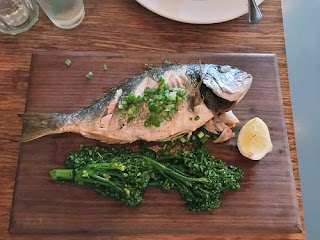from
Behind the French Menu
by
Bryan G. Newman
behindthefrenchmenu@gmail.com
The Taureau de Camargue was the first breed of French cattle to be awarded an AOC, now an AOP, for the unquestionably excellent and consistent quality of their meat. When the Taureau de Camargue is on the menu, you will have an opportunity to enjoy some of the best steaks or roasts that France can offer; in the winter fabulous stews will be on the menu.
The Camargue where the cattle are raised is a working nature reserve and part of the Delta of the Rhone River on France’s Mediterranean coast; it is partly in Provence, Alpes-Côte d'Azur; and partly in Occitanie. (The new Super Region of Occitanie was created on 1-1-2016 by combining the regions of Languedoc-Roussillon and Midi-Pyrénées).
The Taureau de Camargue AOC/AOP are completely free range and looked after by real French cowboys, called gardiens. who also look after the Camargue’s wild white horses. The breed is black and dark brown bulls and cows that are descended from the great Spanish fighting bulls; however, they are physically much smaller and are now considered an entirely separate species.
Wild horses of the Camargue
To hold their AOC/AOP the animals must be antibiotics and growth hormone free, and 90% of their food comes from natural grazing. Your first bite will tell you that the texture and taste of this meat is different.
The Taureau de Camargue on French menus:
Carpaccio de Taureau, Parmesan, Cebette et Câpres - A Carpaccio of Taureau de Camargue prepared with Parmesan cheese, spring onions and capers.
Côte de Taureau de Camargue Grillée au Thym, Sauté de Pomme de Terre à la Ciboule – A rib roast of Camargue beef grilled with thyme and served with potatoes fried with scallions (green onions). A French rib roast has four ribs and will weigh 3 kilos or more, so you will be served slices. You will be asked to choose how you prefer the meat to be cooked, so click here to reach the post on how to order steaks (and roasts) cooked the way you like them.
A Taureau de Camargue rump steak.
https://www.flickr.com/photos/marsupilami92/16897832010/
Entrecôte de Taureau de Camargue, Sauce Béarnaise, Pommes de Terre Rate au Four, Légumes du Moment - An entrecôte steak, a US or UK rib-eye. An entrecote, in France, is nearly always grilled and here it is served with Sauce Béarnaise. Accompanying the steak are baked “rate” potatoes, one of France’s most popular potatoes, along with the freshest vegetables.
Gardiane de Taureau et son Riz de Camargue - The stew of the Gardians, a stew as the Camargue's French cowboys would prepare. This stew is a variation of Provence’s memorable beef daube made with red wine, and here it is served with rice grown in the Camargue. (For more about the foods grown and served on the Camargue click here).
Pièce de Filet de Taureau de Camargue AOC Sauce au Vin Rouge, Purée de Pomme de Terre à l'Huile d'Olive – A filet steak from the Taureau de Camargue prepared with a red wine sauce and served with pureed potatoes flavored with olive oil.
Among the Camargue’s many traditions and one in which the Taureau de Camargue take part in is the Course Camarguaise, the Camargue acrobatic competition or contest. The Course Camarguaise is certainly not a bull-fight as some translations suggest; it is a unique acrobatic attraction, and the gardiens do not let their bulls, or, more often, the cows, get hurt or wounded; these animals are trained professionals. To see more on the Camargue see the post: The Camargue, France. The land, its people, and its unique cuisine.
A Course Camarguaise
https://www.flickr.com/photos/hern42/3930446271/
Behind the French Menu
------------------------
Behind the French Menu
by
Bryan G. Newman
behindthefrenchmenu@gmail.com
Copyright 2010,
2013, 2019.
----------------------------------------------
Searching for the
meaning of words, names or phrases
on
French menus?
Just add the word, words, or phrase that
you are searching for to the words "Behind the French Menu" and
search with Google. Behind the French Menu’s links include hundreds of words,
names, and phrases that are seen on French menus. There are over 450 articles
that include over 4,000 French dishes with English translations and
explanations.
-------------------------------
Connected posts:




















